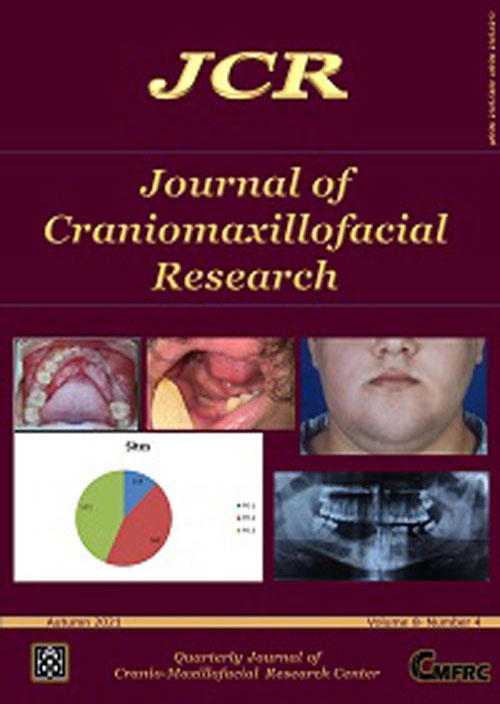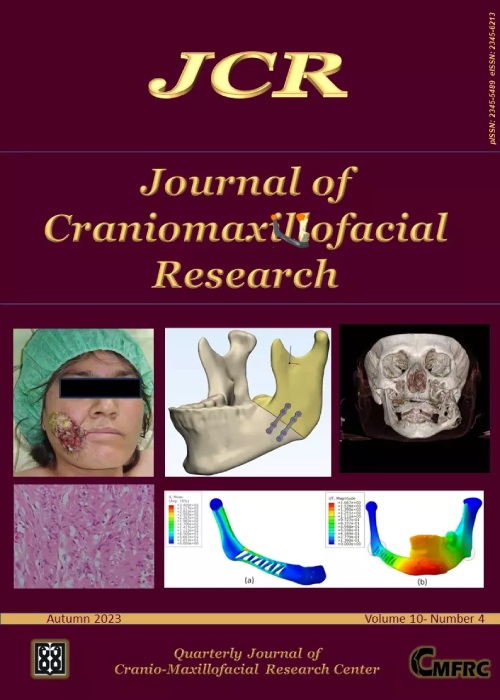فهرست مطالب

Journal of Craniomaxillofacial Research
Volume:9 Issue: 1, Winter 2022
- تاریخ انتشار: 1401/08/11
- تعداد عناوین: 7
-
-
Pages 1-18Objective
Maxillofacial Orthognathic surgery is performed to repair or correct the skeletal anomalies of the jaw and its associated dental and facial structures. There is a conflict on whether orthognathic surgery has a negative or positive effect on temporomandibular disorders (TMD). The aim of this study is to review the disorders of the temporomandibular joint after orthognathic surgery.
Materials and MethodsData for this review was obtained from the articles published between 2010-2020 via PubMed, Google scholar, Web of Sciences, and Scopus engines. The content keywords matched those used in PubMed and Mesh engines. Based on the inclusion and exclusion criteria; 27 articles were included.
ResultsMost of the selected articles were retrospective reviews and performed on class II and class III patients. Ages ranged from 19- 47 years. Pain reduction was reported in 11 studies, while 8 studies reported a click reduction post orthognathic operation. In 2 studies, decreased joint noises was reported after orthognathic operation, and 7 articles reported a decrease in maximum mouth opening. Three studies reported a Bilateral Sagittal split Osteotomy (BSSO) and in one study, reduced and improved symptoms after Le Fort I + (BSSO) were reported. One study exhibited that BSSO orthognathic surgery is less predictable in reducing TMD symptoms in retrognathic patients. Three articles showed that orthognathic patients with TMJ click have a high predictive value.
ConclusionTo accomplish accurate results regarding temporomandibular joint disorders post orthognathic surgery; a larger number of subjects and clinical trial studies are required, as well as extended long term follow-up.
Keywords: Temporomandibular joint, Mandibular advancement, Mandibular setback, Maxil- lary impaction, Maxillary advancement -
Pages 19-22
Bilateral sagittal split ramus osteotomy is one of the most versatile techniques in orthognathic surgery that allows for the repositioning of the mandible in all directions. This osteotomy splits the mandible into two proximal condyle-bearing segments and one distal tooth-bearing segment.Intraoperatively, the surgeon is usually focused primarily on the proper positioning of the distal segment to achieve the planned amount of advancement or setback. However, particular attention should be paid to the position of the proximal segment, as improper positioning of the proximal segment during fixation gives rise to immediate or late relapse of the surgical outcomes. The goal of this paper is to provide some background knowledge about the proximal segment for the novice surgeons, based on a review of the relevant literature. What is the proper position of the proximal segment, and what is the best technique to guide the proximal segment into its proper position?. These questions do not have clear-cut answers that the majority of surgeons agree on.
Keywords: Orthognathic surgery, Osteotomy, Mandibular condyle, Proximal segment, Sagittalsplit -
Pages 23-30Background
The aim of this study was to evaluate the histopathological findings of oral lesions in patients referred to the pathology department of Kosar Hospital of Semnan city (Iran) in 2012-2018.
Materials and MethodsThis population-based cross-sectional study was concocted on the histopathological findings of oral lesions 137 patients referred to the pathology department of Kosar Hospital of Semnan city (Iran) in 2012-2018. The sampling method was census. The data collection tool was a check including demographics and dentistry (type of dental lesion, location of the lesion, malignancy of lesions, origin of dental lesions, side of the lesion conflict, jaw involved, anterior-posterior position and type of biopsy). SPSS24 was used for data analysis and a significance level of less than 0.05 was considered.
ResultsThe most common type and the most common location of oral lesions were periapical cyst (16.7%) and periapical (28.3%); respectively. The most common sources of oral lesions were related to inflammation and connective tissue with 27.5 and 26.8%, respectively. Mandible (47.8%) was the most common involved jaw and 5.1% of reported lesions were malignant. In addition, the prevalence of periapical cyst (78.3 vs. 21.7%) and pyogenic granuloma (82.4 vs. 17.6%) were significantly higher in women than men (P-Value=0.035).The highest rates of periapical cyst (43.5%)and pyogenic granuloma (58.5%) were observed in the age group ≤30 and 31-40 years; respectively(P-Value=0.013).
ConclusionThis study suggests that the female patients and over 40 years should be more careful to check for periapical cyst. However, more detailed studies with higher sample sizes are recommended.
Keywords: Histopathological findings, Oral lesions, Periapical, Periapical cyst, Iran -
Pages 31-39
Objective :
One of the concerns of dentists is the referral of patients with temporomandibular problems. Temporomandibular joint disorders (TMD) is a complex multifactorial clinical problem that involves masticatory muscles, temporomandibular joint and related structures. Thiscomplication is one of the three common chronic pains after headache and low back pain, which can manifest as pain in the temporomandibular region and limitation in joint movements, or even as clicking, crepitus, and popping sounds during temporomandibular joint movements. For the first time, the american association for oral pain (AAOP) proposed the role of genetic factors in the development of TMD. It is thought that a complex disorder such as TMD is multidimensional and can be subjected to environmental conditions as well as multiple gene polymorphisms. Identification of single nucleotide polymorphisms in the human genome can play an important role in clinical setting for diagnosis, prognosis and therapeutic interventions in various diseases including TMD. The aim of this study was to evaluate the relationship between polymorphism of galactose mutarotase gene by creating jaw sound in patients with temporomandibular disorder in a population with high similarity to the whole Iranian population and using the results in prevention and targeted treatment of affected patients.
Study Design:
101 patients with TMD using DC/TMD criteria among those referred to Tehran University School of Dentistry and 103 healthy subjects for TMD that have age and gender matched were selected to control groupfrom those referring to the Oral and Maxillofacial Diseases and Oral and Maxillofacial Pain departments. Blood samples were taken in 5cc and DNA extracted from the blood of both groups by applying the technique PCRARMS in terms of polymorphism rs4776783 in Galm gene were Compared.
Results:
101 patients with TMD along with 103 healthy individuals without a history of TMD were evaluated to investigate rs4776783 polymorphism in GALM gene. The average age of the patients was 35.92, and 21 were men and 80 were women. According to the questionnaire, 61 people felt the sound in their jaw while moving. On the other hand, according to the TMD/DC criterion, the number of people who have crepitus in the right and left jaws is equal. The average age of the patients was 35.92, and 21 were men and 80 were women. According to the questionnaire, 61 people felt the sound in their jaw while moving. On the other hand, according to the TMD/DC criterion, the number of people who have crepitus in the right and left jaws is equal. The low prevalence of crepitation with p=0.734 has a significant relationship with the genotype of people.
Conclusion:
This study showed that there is a significant relationship between the rs4776783 polymorphism in Galm gene and the occurrence of temporomandibular disorder (TMD), jaw sound and pain in many masticatory muscles such as lateral pterygoid and temporal. Therefore, it can be concluded that TMD has a genetic basis.
Keywords: Galactose mutarotase, GALM, Temporomandibular disorder, Polymorphism -
Pages 40-44Purpose
The aim of this study was to determine the influence of multiple layers of die relief agent and different cement thickness on the retention of cast restorations using two different cements.
Materials and Methods144 standard stainless steel dies were divided into two groups. Each of them includes 72 dies. These groups were divided into 12 equal subgroups as well. In both groups, die spacer was applied to dies in 0, 3, 4, 5, 6 and 7 layers (each layer=5μ). In the first group,crowns were cemented with Zinc Phosphate and in the second group, Polycarboxylate was used forcementing. After that, the strength required for separating the castings from the dies was measured.
ResultsThe difference among 12 subgroups analyzed by one-way ANOVA regarding Polycarboxylate cement did not reach statistical significance. (P=0.95). A similar result was obtained with zinc phosphate cement (P=0.616). Likewise, the two-way ANOVA was carried out between the zinc phosphate and polycarboxylate groups. There was a significant difference between the average of two groups (P<0.001).
ConclusionRange of cement layer thickness that used in this study didn’t statistically significantly affect the force required to remove cemented cast copings. Although the castings cemented with Zinc Phosphate needed higher force to be dislodged from dies.
Keywords: Cement space, Die spacer, Retention, Polycarboxylate cement, Zinc phosphate ce- ment -
Pages 45-51Background and Aims
Maxillofacial traumas are common injuries caused by accidents and occurrences such as falls or injuries. In this study, we examined the knowledge and practice of medical interns in this field, due to the fact that after the accident general physicians and medical interns are the first line of treatment.
Materials and MethodsA two-part questionnaire was prepared including knowledge and practice that presents different scenarios of trauma emergencies. Questionnaires were distributed among medical interns. A total of 152 questionnaires were received and the data was analysed, statistically.
ResultsThe results obtained from this study showed that the level of dependent parameters, i.e. knowledge and practice of participants did not have a significant relationship with independent variables, i.e. age, gender and the duration of internship expressed as months past. On the other hand, it was found that there is a low level of knowledge and poor practice (mean score of 22.2 and 55.5, respectively) among medical interns.
ConclusionA focused training program is highly recommended and workshop sessions should be held to elevate the level of awareness and practice regarding dental trauma among medical interns.
Keywords: Awareness; Practice; Trauma; Tooth; Mouth.Keywords: Awareness, Practice, Trauma, Tooth, Mouth -
Pages 52-56
Metastatic disease to the oral cavity is rare, representing only 1-8% of oral malignancies, and involvement of the mandibular ramus is even less prevalent. This report is a unique case of metastatic adenocarcinoma of the colorectal to the mandible. Clinical presentation can be quite variable, and most often a primary malignancy is already known. Jawbone metastasis are a sign of disseminated malignant neoplasms, with poor prognosis and usually an indication for palliative therapy. The requirement for arrival at an appropriate and prompt diagnosis is crucial for determining the most appropriate treatment regimens and improved outcomes. The oral metastatic lesion may be the first indication of an undiscovered distant primary tumor, making timely evaluation and treatment critical from an oncologic perspective. Here we report a known case of mucinous adenocarcinoma of colon who was referred due to a mandibular lesion. Keywords: Mandible; Mucinous adenocarcinoma; Metastasis.
Keywords: Mandible, Mucinous adenocarcinoma, Metastasis


